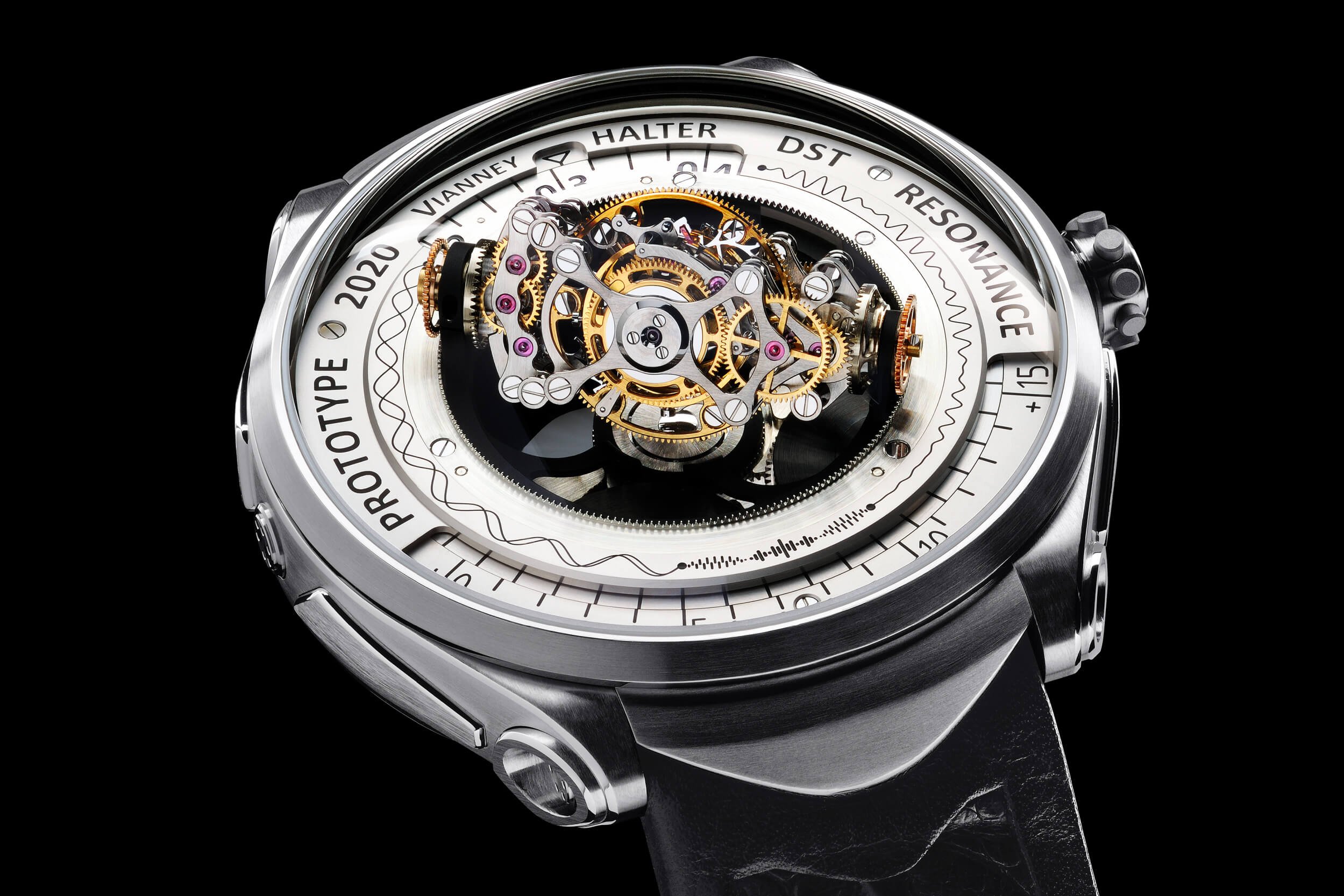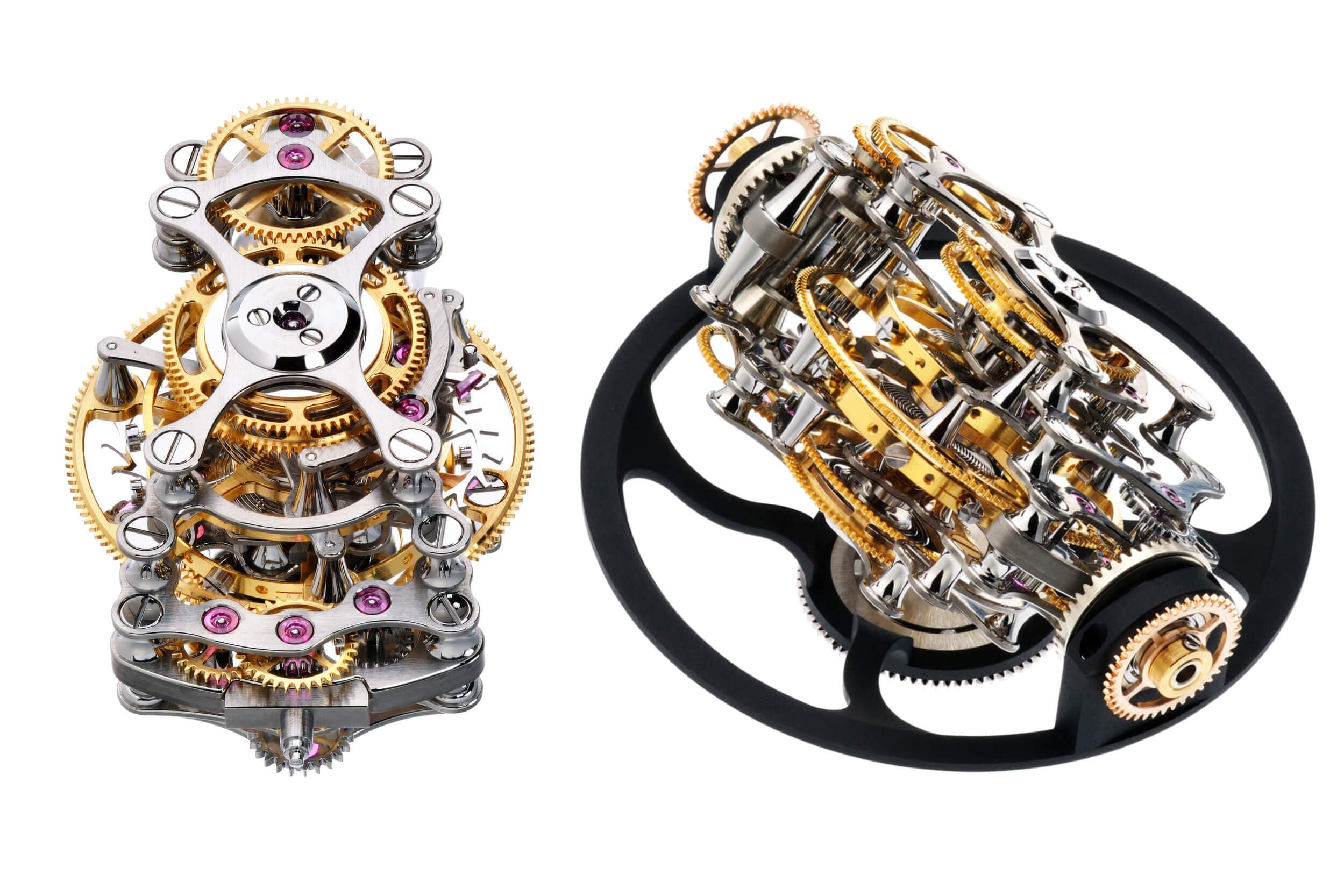Deep Space Tourbillon Resonance by Vianney Halter

Transporting his other worldly Deep Space Tourbillon into a new dimension of technical sophistication, celebrated indie master Vianney Halter took what was an already profound creation and elevated it into the realms of the surreal.
If you’ve already created a career defining masterpiece which has been universally deified as being one of the most spectacular, complex and iconic watches of the past decade of contemporary independent watchmaking, what do you do to follow something like that?
How do you follow one of the most distinctive and celebrated pieces of contemporary independent watchmaking? The original Deep Space Tourbillon by Vianney Halter, as photographed in 2014.
Plucking the inspirations for his extraordinary creations from interests in fields as diverse as the works of pioneering horologic innovators like Antide Janvier, or the steampunk aesthetics of Jules Verne, and even the retro-futuristic fantasy of classic twentieth century science fiction, Vianney Halter is emphatically not what one would ever consider to be a conventional watchmaker. A non-conformist, a dreamer, a visionary and a genius inventor and problem solver, if he is indeed a mere mortal, then he is definitely wired a little differently to the rest of us.
Halter’s work has only ever been constrained by the limits of his own imagination, and if, like an artist, a watchmaker’s work could ever be considered as some kind of window into his or her personality, then across his career, woven into each of his extraordinary creations has been the recurring DNA of an eccentric, one of a kind scientist. Which would be pretty accurate.
And so, for Vianney Halter, the sequel to his otherworldly 2013 Deep Space Tourbillon opus meant returning to what was to him a matter of unfinished business. Determined to up the ante and return with an even more bewilderingly complex piece of mechanical sorcery, he immersed himself in the challenge of tackling and taming for once and for all time a long-standing personal nemesis, the solution to which had teased, tantalised and tormented his subconscious for more than twenty years. The grail in question was one of the most mysterious, elusive and perplexing of all horological phenomena; the ghostly enigma which is true untethered acoustic resonance. And the result…
If the Deep Space Tourbillon Resonance (or DST-R), looks familiar, that’s because of course, in many ways, it is familiar. Based on the same Kubrick-esque space station styling of its predecessor, the Deep Space Tourbillon, the DST-R Prototype retains those dramatic, head-turning aesthetics. That unmistakable exaggerated dome of sapphire crystal, which bulges above a mesmerising three dimensional display, with its twisting, revolving and rotating kinetic sculpture an utterly commanding spectacle, as it gyrates on three axes inside a deep void-like cavity at its centre. It is well named.
A mere moment’s closer inspection however reveals that these cosmetic similarities apart, the DST-R is a very different proposition indeed. Principally it features one very significant difference, and that is to be found right at the heart of the mechanism. This is where two balance wheels oscillate, eye to eye and operating in perfect synchronicity, despite having no physical connection other than the solid structure they share. Relying purely on the invisible force of acoustic resonance, which is achieved via gravitational waves generated by the ultra-precise proximity of the two balances to each other, they communicate in the silent and unspoken language of frequency, across the invisible void of air between them.
Inspired by the pursuit of the peculiar phenomena of resonance, first discovered and applied to horology by Abraham Louis Breguet and Antide Janvier in the late 1700s, the Deep Space Resonance is the result of two decades of contemplation, reasoning and rationalising by the watchmaker, as he experimented into the characteristics and effects of acoustic vibration. A lesser known side to Vianney Halter is his fondness for the piano, yet via an oblique association, this would become a significant factor in the development of his watch. That’s because it was while learning to play and tune the instrument in the 1990s, he observed, quite by chance, how the effect of striking one key could evoke a vibration elsewhere, specifically on neighbouring harmonic strings of the same note.
Taking a mental note of this peculiar anomaly, and storing it away in his mind for future musings, it wasn’t very long before it dawned on the young watchmaker that what this was in fact were the effects of acoustic resonance. It became something he would find himself returning to time and again over the intervening years, his curiosity piqued by an innate engineer’s instinct which informed him that somehow, in some strange way, this curious correlation between those piano strings was unquestionably leading to a predestined manifestation in another sphere of his life.
Exactly how and in what guise, however, was another matter, and one yet to properly reveal itself, but the seed was sown in a highly furtive imagination, and it was putting down roots.
Whilst working on the many projects which would establish him as one of the most notable creative talents upon the nascent landscape of 21st century independent watchmaking, in the background Halter continued to court an on-off relationship with his mysterious muse, studying, learning and gradually cajoling out its mysterious secrets through trial end error, until that eureka moment when something finally clicked, and clicked again, and then again, and the enigma was no longer beyond the realms of possibility. It’s worth remembering that it’s easy to condense the work of many years into a few sentences.
The revelation which confirmed his theory came about while testing, using a pair of identical Russian-made marine chronometer desk clock movements, which he had dismantled and then reconstructed, mounting them back to back on two sides of a brass plate, but overlapping only where their balance wheels shared the same aperture. Oscillating at the same frequency they seemed to be bound together by an invisible tether, which could withstand changes in orientation, as well as synchronising when their harmonious rhythm was disrupted. Halter’s principle was established.
For the watchmaker, proof of concept was of course only half of the battle, and the challenge remained to somehow find a way of adapting his discovery into a functioning timepiece. Of all of his creations to date, one in particular seemed to have the potential to not only house the delicate assembly, but to make a spectacle of it while doing so. With its huge central cavity providing the perfect amphitheatre in which to showcase this unparalleled marvel of physics. the Deep Space Tourbillon was the natural setting for Halter’s new horological extravaganza.
Even with this possibility, there were still major obstacles to overcome. For one thing, the entire engineering fundamentals of the existing triple axis tourbillon would require a complete rethink if the two resonating balances were to be embedded at the heart of the mechanism. In fact at this point, a moment’s pause for comparison between the 2013 Deep Space Tourbillon and the 2021 Deep Space Resonance, reveals that while aesthetically they have much in common, in reality, they are two very different beasts indeed.
Comprising no less than 371 individual components, the animated mechanical centrepiece is as complex as it is beautiful, and utterly fascinating to look at as its three axes circulate the construction in every dimension. Each part manufactured by hand and finished to the uncompromising standards of haute horlogerie, its multi-level architecture is accentuated by the forty-two sculpted polished pillars which space the bridges that hold everything in place; these a truly gorgeous detail borrowed from a marine chronometer manufactured in 1839 by Achille Benoît; one of many historical and influential artefacts which Vianney Halter had acquired along the way.
An extraordinarily sophisticated piece of work, the entire assembly revolves around the dial on a black carousel once every thirty minutes, which itself is driven by a pair of toothed wheels at either end, around a circular track at the centre of the dial. As this is happening, on the horizontal axis the traverse chassis is also gyrating through 360º in a six minute cycle, offering a three dimensional view of every detail of the mechanism from every angle as it goes around. Finally, the innermost tourbillon cage, which contains the central gears and differentials, as well as the acoustically coupled balances and their escape wheels, rotates at the very heart of the watch every sixty seconds.
The resonating balances also threw up another unexpected quirk of their own, when it was discovered in testing that from a standing start, they might begin to oscillate in the opposite direction than which they had previously. Yet even if they did or did not, the synchronising effect remained unaffected. Even their oscillating rate of 21’600 vib/h could fluctuate minutely, so as both were locked into a harmonious and constant rhythm, which would remain until the sixty-five hour power reserve became exhausted.
As elaborate and captivating as it is to the observer, to Halter nothing about the DSR’s technical construction is superfluous to its requirements, and this ‘simplistic’ logic also applies to the time display. Based on the functionality of the Vernier caliper, a precise measuring instrument invented in 1631, and still widely used in the sphere of engineering today, the hours and minutes are indicated in windows at the twelve and six respectively. Both are displayed via rotating discs, with the hours passing under a downward-pointing arrow-head at the top of the dial. The minutes on the other hand (even though there are no hands - another notable difference between the DSR and the original Deep Space), are shown in the bottom window, where again a disc rotates around a static scale. Here though, to the uninitiated eye, taking a reading is not as straightforward as might first appear. This is because, during any fifteen minute cycle, only two of the thin reference lines which represent the minutes are perfectly aligned, with all of the others arranged in a disjointed fashion. It is the aligned lines which display the minute, and so while it quite quickly becomes familiar, it can bemuse, and require a little mental gymnastics to work out at first. This is a Vianney Halter creation after all.
The Deep Space Tourbillon Resonance Prototype by Vianney Halter displaying the time at 3:05
The prototype version of the Deep Space Resonance is manufactured in Grade 5 titanium, and measures 46mm across, standing 20mm tall to the top of its sapphire dome, while a solid titanium caseback conceals the in-house manual winding VH113 movement.
A remarkable watch from a remarkable watchmaker, whose career is punctuated with convention-defying, and surely historically significant milestones along the timeline of contemporary independent watchmaking, the DSR really is an extension of the man and his unbridled fascination with the application of science fact and science fiction in watchmaking. He might even come from another universe, but his latest brainchild proves that life here on earth would be pretty boring without him.







